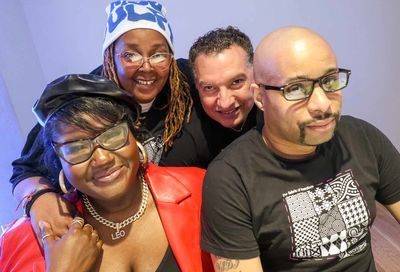Giorgio Moroder: 10 of his classic productions
It’s impossible to overstate the importance of Giorgio Moroder to pop and dance music in the late ’70s and throughout the ’80s and beyond. His influence has been enormous. The 73-year old Italian songwriter and producer has been involved with countless hits, including some of the biggest singles of the pop era. His work with Donna Summer, especially on “I Feel Love,” was revolutionary and imitators proliferated in every direction in his wake. In the ’80s he worked on numerous soundtracks, and scored multiple major hits. This past year, on their “Random Access Memories” album, Daft Punk paid homage to him with the 9-minute track “Giorgio by Moroder,” which features Giorgio himself explaining his background and how he came up with his sound. Given the increased interest in Giorgio Moroder thanks to the Daft Punk track, here are 10 of the biggest singles on which he was producer, songwriter, or both.
Donna Summer – “I Feel Love”
Giorgio Moroder changed the face of music with his innovative production on Donna Summer’s “I Feel Love.” Using a revolutionary technique with an entirely synthesized backing track and mechanized beats, “I Feel Love” completely changed disco, pop and dance music when it was released in 1977. The track sent shockwaves through the music industry, and became a massive hit. “I Feel Love” is one of the most influential singles in pop music history. Moroder produced a number of other classics for Donna Summer, including “Love to Love You Baby,” “Bad Girls,” “Hot Stuff” and “MacArthur Park.” Even if he had never worked with another artist, his production work with Donna Summer would justify his status as a legendary producer.
Giorgio Moroder – “From Here To Eternity”
Moroder recorded and released his own music in addition to working with other artists, and his most famous single is undoubtedly “From Here to Eternity,” a disco classic from 1977 that got all the way to #2 on the U.S. dance charts. Note the similarity in musical style to “I Feel Love.” Moroder’s trademark sound would serve him well in the years to come as he became more and more successful, and focused increasingly on film work.
Blondie – “Call Me”
Giorgio Moroder produced and co-wrote the smash 1980 single “Call Me” by Blondie from the film American Gigolo. The hard-rocking mix of guitar riffs over Moroder’s trademark electronic dance beat and Debbie Harry’s terrific vocal proved a potent combination and the song spent 6 weeks at #1. Moroder wrote the instrumental track, Debbie Harry provided the lyrics and a classic was born.
David Bowie – “Cat People (Putting Out Fire)”
Bowie wrote the lyrics and delivered a dramatic, smoldering vocal performance and Moroder wrote and produced the music on “Cat People (Putting Out Fire)”, the theme from the 1982 film Cat People. Bowie would end up recording a far inferior version for his 1983 album “Let’s Dance,” but the Moroder version would gain new life in 2009 when Quentin Tarantino used it during a key sequence in his Oscar-nominated film Inglourious Basterds.
Irene Cara – “Flashdance… What a Feeling”
Moroder produced and co-wrote the #1 title song to the 1983 film Flashdance, with vocalist Irene Cara and Keith Forsey collaborating on the lyrics and Moroder handling the music. “Flashdance… What a Feeling” would spend 3 weeks at the top of the U.S. singles charts and would go on to win an Oscar for Best Original Song. It would become one of the most iconic singles of the ’80s, an instantly recognizable classic that helps define pop and dance music for the decade.
Limahl – “The Neverending Story”
Moroder continued his sountrack work with the 1984 fantasy film The Neverending Story, an adaptation of the classic Michael Ende novel. He wrote much of the score for the American version of the film, and produced and co-wrote the lyrics with collaborator Keith Forsey for the title song, which became a hit for former Kajagoogoo vocalist Limahl (best known for their smash 1983 hit “Too Shy,” which was produced by Duran Duran’s Nick Rhodes). “The Neverending Story” features Moroder’s trademark electronic beats and waves of synthesizers, and managed to reach #17 on the U.S. singles chart. It was Limahl’s only solo hit in America.
Bonnie Tyler – “Here She Comes”
In 1984, Giorgio Moroder created an updated version of the 1927 film “Metropolis” with a modern score and a soundtrack that he composed featuring contemporary artists such as Pat Benatar, Adam Ant, Freddie Mercury and Loverboy. The film was a flop and the soundtrack didn’t do much better, but it did yield the terrific single “Here She Comes” recorded with Bonnie Tyler, who was fresh off her mega smash single “Total Eclipse of the Heart.” A great pop single and a forgotten gem of the ’80s.
Giorgio Moroder and Philip Oakey – “Together in Electric Dreams”
Moroder composed much of the score for the 1985 film Electric Dreams, and collaborated with Human League vocalist Philip Oakey on the soaring title track, which became a massive hit in the U.K. (although it did not make a chart impact in the U.S.). The track is often mistakenly assumed to be the Human League as it fits right in with their signature synth-pop sound, and it was included on one of their Greatest Hits collections. The collaboration was so successful that the two would end up recording an entire album together, which would yield a couple minor hits in “Be My Lover Now” and “Goodbye Bad Times.”
Berlin – “Take My Breath Away”
Giorgio Moroder earned another Oscar for Best Original Song for his composition and production “Take My Breath Away,” a soaring ballad from the 1986 Tom Cruise blockbuster Top Gun. Berlin vocalist Terri Nunn added her vocals to Moroder’s backing track, and “Take My Breath Away” became a #1 smash in the U.S. It would also be included on Berlin’s 1986 album “Count Three & Pray,” but caused tension in the band because of the lack of involvement by the other members and the fact that it was a complete departure from the band’s usual style. “Take My Breath Away” was Berlin’s biggest hit by far; their only other Top 40 hit in America was the #23 single “No More Words” from 1984.
Kenny Loggins – “Danger Zone”
Another smash from the film Top Gun was “Danger Zone,” a song co-written and produced by Moroder and sung by ’80s soundtrack mainstay Kenny Loggins. It was a bit of a more hard-rock sound than usual for Moroder, but it proved massively successful. “Danger Zone” reached #2 on the U.S. singles charts and has remained an iconic ’80s single. It is one of the biggest hits of Loggins’ long career, along with an other ’80s soundtrack classic “Footloose.”
These ten tracks are just a sampling of the vast body of work that Giorgio Moroder has been involved with over a span of over 40 years. He is a pioneer in disco and pop music, and has influenced countless other artists and producers. Just this year he remixed Donna Summer’s “Love to Love You Baby” for a collection of new mixes of her classic tracks called “Love to Love You Donna.” Lately he has been appearing as a DJ, playing classic remixes and new material, and in recent years has uploaded a number of rare remixes to his Soundcloud page. Giorgio Moroder is a legend, and his already immense legacy only continues to grow, with an assist to Daft Punk who hopefully have helped a new generation of music fans discover the great work Giorgio Moroder has done over the decades.
Other recent articles:
Annie Lennox turns 59 – – we explore 10 of her best hidden gems
The 30 Best Albums of 2013
The Best and Worst Singles of 2013
Support Metro Weekly’s Journalism
These are challenging times for news organizations. And yet it’s crucial we stay active and provide vital resources and information to both our local readers and the world. So won’t you please take a moment and consider supporting Metro Weekly with a membership? For as little as $5 a month, you can help ensure Metro Weekly magazine and MetroWeekly.com remain free, viable resources as we provide the best, most diverse, culturally-resonant LGBTQ coverage in both the D.C. region and around the world. Memberships come with exclusive perks and discounts, your own personal digital delivery of each week’s magazine (and an archive), access to our Member's Lounge when it launches this fall, and exclusive members-only items like Metro Weekly Membership Mugs and Tote Bags! Check out all our membership levels here and please join us today!




















